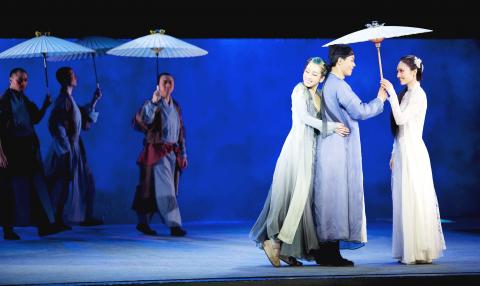Green Snake (青蛇) , the smash theater hit produced by China National Theater (中國國家話劇院), is a wild departure from its original source.
Legend of the White Snake (白蛇傳) narrates the romance between the demon White Snake and the handsome human scholar Xu Xian (許仙), as well as the quest of monk Fahai (法海) to break up the forbidden love. It’s a chaste romance, and Green Snake is strictly not.
“This is a story about seduction,” Tian Qinxin (田沁鑫), the play’s director, told the Taipei Times in a phone interview.

Photo courtesy of Taipei Arts International Association
Adapted from the acclaimed novel by Hong Kong novelist Lilian Lee (李碧華), Tian’s play turns the spotlight to Madame White Snake’s faithful companion, Green Snake, who also craves human love — and sex.
Jealous of the relationship between White Snake and Xu Xian, Green Snake is willing to forsake her immortality to steal him, leading to a disastrous romantic triangle. White Snake seduces Xu Xian to save her marriage, while Fahai seduces Xu Xian in an attempt to break up the taboo marriage. The play unfolds like a psychological drama, filled with anger, lust and temptation.
Chinese thespian Qin Hailu (秦海璐), who has won three Golden Horse Awards, takes the leading role of Green Snake in a sultry performance that was well-received in China and Hong Kong.
The cast also includes actress Jin Ge (金戈) as Lady White Snake, Dong Chang (董暢) as the handsome male scholar Xu Xian and Xin Baiqing (辛柏青) as the monk Fahai. There are three shows from Aug. 9 to Aug. 11 at the National Theater Taipei. Performances are in Mandarin, with Chinese and English subtitles.

The 1990s were a turbulent time for the Chinese Nationalist Party’s (KMT) patronage factions. For a look at how they formed, check out the March 2 “Deep Dives.” In the boom years of the 1980s and 1990s the factions amassed fortunes from corruption, access to the levers of local government and prime access to property. They also moved into industries like construction and the gravel business, devastating river ecosystems while the governments they controlled looked the other way. By this period, the factions had largely carved out geographical feifdoms in the local jurisdictions the national KMT restrained them to. For example,

April 14 to April 20 In March 1947, Sising Katadrepan urged the government to drop the “high mountain people” (高山族) designation for Indigenous Taiwanese and refer to them as “Taiwan people” (台灣族). He considered the term derogatory, arguing that it made them sound like animals. The Taiwan Provincial Government agreed to stop using the term, stating that Indigenous Taiwanese suffered all sorts of discrimination and oppression under the Japanese and were forced to live in the mountains as outsiders to society. Now, under the new regime, they would be seen as equals, thus they should be henceforth

With over 100 works on display, this is Louise Bourgeois’ first solo show in Taiwan. Visitors are invited to traverse her world of love and hate, vengeance and acceptance, trauma and reconciliation. Dominating the entrance, the nine-foot-tall Crouching Spider (2003) greets visitors. The creature looms behind the glass facade, symbolic protector and gatekeeper to the intimate journey ahead. Bourgeois, best known for her giant spider sculptures, is one of the most influential artist of the twentieth century. Blending vulnerability and defiance through themes of sexuality, trauma and identity, her work reshaped the landscape of contemporary art with fearless honesty. “People are influenced by

The remains of this Japanese-era trail designed to protect the camphor industry make for a scenic day-hike, a fascinating overnight hike or a challenging multi-day adventure Maolin District (茂林) in Kaohsiung is well known for beautiful roadside scenery, waterfalls, the annual butterfly migration and indigenous culture. A lesser known but worthwhile destination here lies along the very top of the valley: the Liugui Security Path (六龜警備道). This relic of the Japanese era once isolated the Maolin valley from the outside world but now serves to draw tourists in. The path originally ran for about 50km, but not all of this trail is still easily walkable. The nicest section for a simple day hike is the heavily trafficked southern section above Maolin and Wanshan (萬山) villages. Remains of